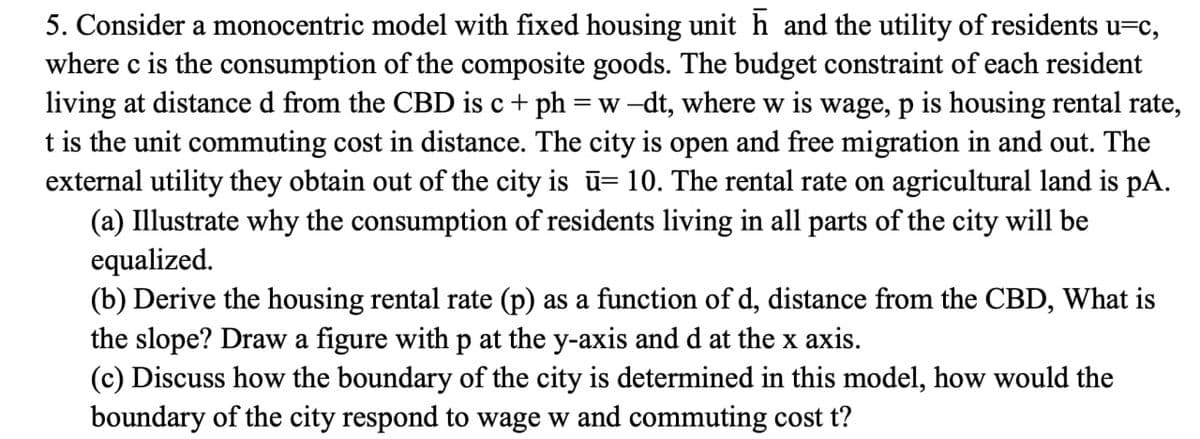5. Consider a monocentric model with fixed housing unit h and the utility of residents u=c, where c is the consumption of the composite goods. The budget constraint of each resident living at distance d from the CBD is c + ph = w-dt, where w is wage, p is housing rental rate, t is the unit commuting cost in distance. The city is open and free migration in and out. The external utility they obtain out of the city is ū= 10. The rental rate on agricultural land is pA. (a) Illustrate why the consumption of residents living in all parts of the city will be equalized. (b) Derive the housing rental rate (p) as a function of d, distance from the CBD, What is the slope? Draw a figure with p at the y-axis and d at the x axis. (c) Discuss how the boundary of the city is determined in this model, how would the boundary of the city respond to wage w and commuting cost t?
5. Consider a monocentric model with fixed housing unit h and the utility of residents u=c, where c is the consumption of the composite goods. The budget constraint of each resident living at distance d from the CBD is c + ph = w-dt, where w is wage, p is housing rental rate, t is the unit commuting cost in distance. The city is open and free migration in and out. The external utility they obtain out of the city is ū= 10. The rental rate on agricultural land is pA. (a) Illustrate why the consumption of residents living in all parts of the city will be equalized. (b) Derive the housing rental rate (p) as a function of d, distance from the CBD, What is the slope? Draw a figure with p at the y-axis and d at the x axis. (c) Discuss how the boundary of the city is determined in this model, how would the boundary of the city respond to wage w and commuting cost t?
Chapter4: Utility Maximization And Choice
Section: Chapter Questions
Problem 4.14P
Related questions
Question

Transcribed Image Text:5. Consider a monocentric model with fixed housing unit h and the utility of residents u=c,
where c is the consumption of the composite goods. The budget constraint of each resident
living at distance d from the CBD is c + ph = w-dt, where w is wage, p is housing rental rate,
t is the unit commuting cost in distance. The city is open and free migration in and out. The
external utility they obtain out of the city is ū= 10. The rental rate on agricultural land is pA.
(a) Illustrate why the consumption of residents living in all parts of the city will be
equalized.
(b) Derive the housing rental rate (p) as a function of d, distance from the CBD, What is
the slope? Draw a figure with p at the y-axis and d at the x axis.
(c) Discuss how the boundary of the city is determined in this model, how would the
boundary of the city respond to wage w and commuting cost t?
AI-Generated Solution
Unlock instant AI solutions
Tap the button
to generate a solution
Recommended textbooks for you

